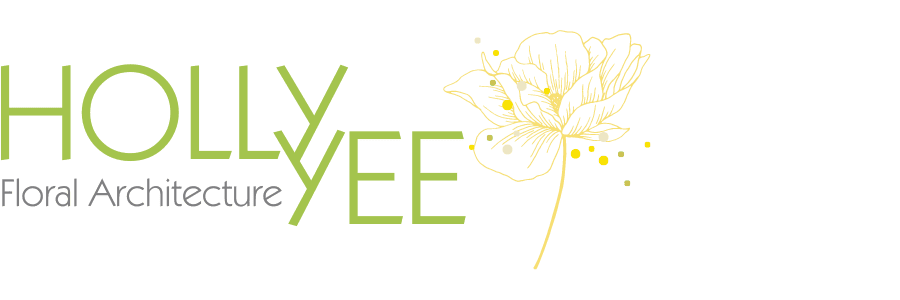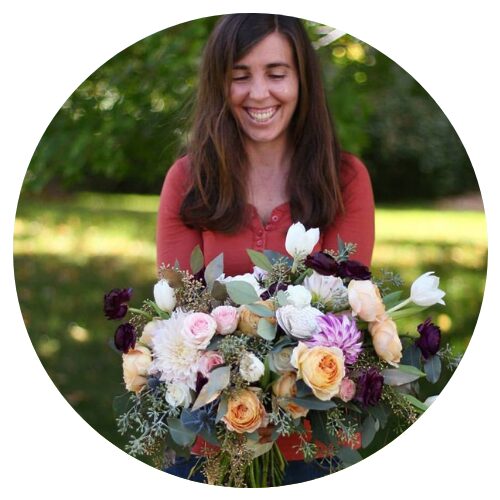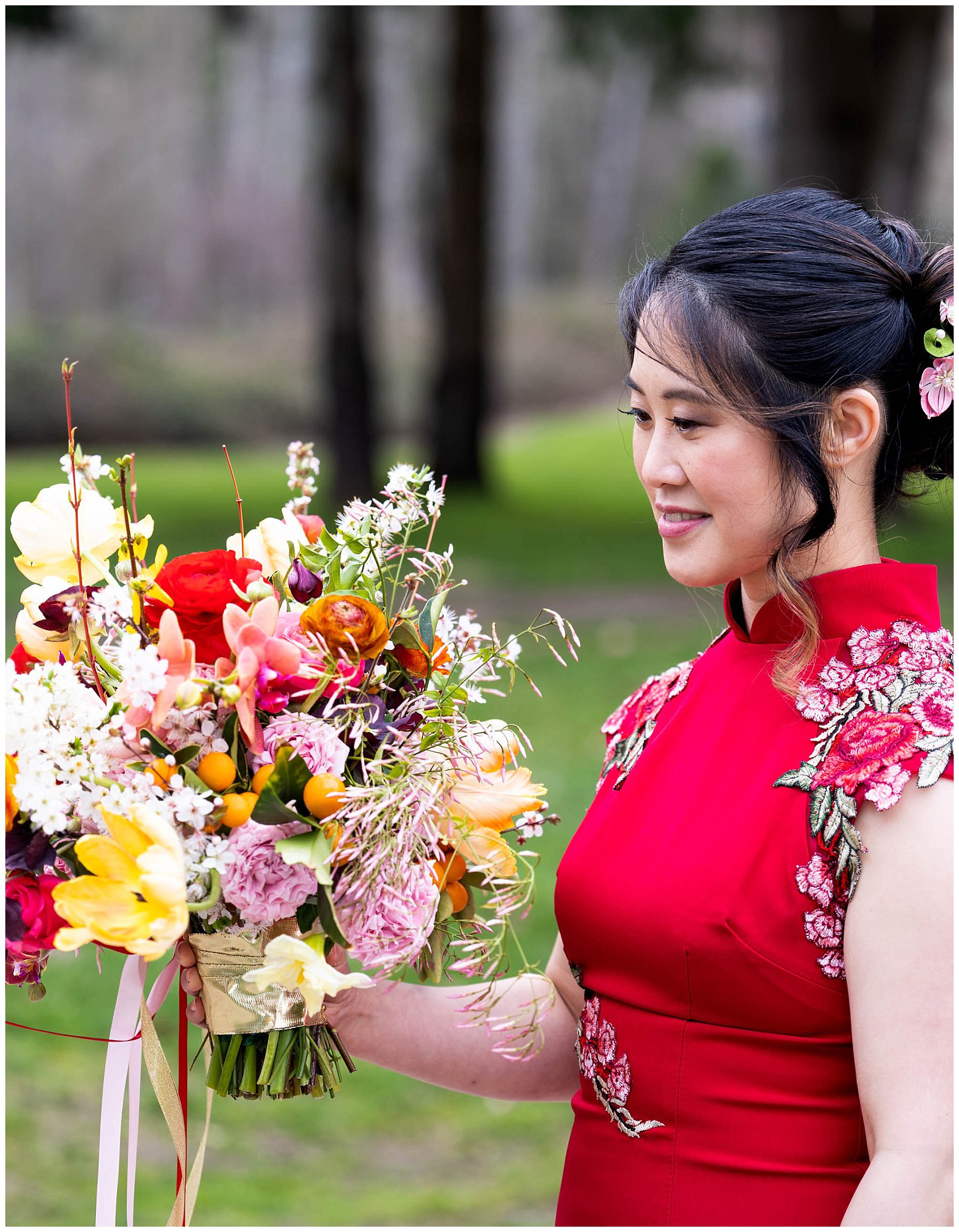
On Saturday morning in late March of this year I open up the door to my floral studio – it’s the start of a very busy day. But I don’t have a wedding.
Today a styled shoot is taking place, one that I have been thinking about and planning for many months. Not only am I the florist, but I am also the interviewer, as well as the photographer. Despite my nerves at all of this responsibility, I am looking forward to the day unfolding. I have just created one of those most beautiful bridal bouquets that I might have ever designed in my entire career. It is bursting with color and I am bursting with excitement to photograph it.
Almost a year earlier, on an overcast Seattle day, Eva Hom formerly of August Skies Weddings and had I sat down over a cup of coffee for a get-to-know-you-better vendor meeting. I had first met Eva the year prior at a wedding professionals networking event. I was looking forward to learning how Eva got into the wedding industry, as every wedding professional has a unique journey into the world of weddings, as well as personal approach to their business and the couples they serve. But I also wanted to ask Eva about a picture of a beautiful red dress on her website that had really piqued my curiosity. A simple line of text next to this small photo had stated: I speak Cantonese and I help couples incorporate cultural elements into their weddings.
The red dress pictured on Eva’s website was the dress she wore to the Chinese banquet her mom hosted in California, about a month after Eva and her husband’s formal wedding here in Washington. Never having designed a bouquet for a red dress, I knew that I could create something spectacular and unique. I asked Eva if she would be willing to collaborate on a shoot using her gorgeous red dress. And luckily for me, she was.
Katey, the fantastic hair and make-up artist of Alluring Makeup Artistry by Katey, pulls up in her car and unloads her beauty supplies. She is also collaborating on this shoot and will be beautifying Eva. Not too long after, Eva arrives with the red dress in tow. Once settled and a little bit into our conversation Eva tells us, “I never got professional hair or make-up with that dress, so I am really excited about this.”
CHINESE ROOTS
Eva was born and raised in California, but she is second generation Chinese-American, so Cantonese was her first language. “My parents came from China, which is why I grew up speaking Cantonese at home,” Eva explains. “And the way I maintained that was by watching a lot of TV with my parents, from the local news to drama shows to Hong Kong movies. I also went to Chinese school every Saturday for many years where I learned to read and write [Cantonese].”
In a city as multi-cultural as Seattle there is no doubt that it’s advantageous to speak more than one language. From my own experience as a small business owner, speaking other languages could have allowed for more efficient and accurate client communication. I once worked with a couple that was deaf. I didn’t know American Sign Language, but was fortunate that the bride could read lips. I remember thinking at the time, however, that it would have been even easier if I knew how to sign.
Eva’s couples don’t necessarily seek her out as a Cantonese speaking wedding planner, but she does find her bi-lingual ability helpful in conversing with Cantonese speaking parents, who might be heavily involved in the wedding planning process, as well as with guests at the wedding. “On the day of they may be flying in from somewhere else and they might not be familiar with the venue or a lot of things that are happening, so I catch them up and help them figure out what’s going on,” Eva explains.
A BUSINESS THAT VALUES DIFFERENT CULTURES

August Skies Weddings was formed at the end of 2019. Eva tells me that after planning her own wedding in 2018, she was hooked. “I had a day of coordinator,” Eva shares. “But I mainly planned the whole thing and I really enjoyed the process.” Wanting to figure out how wedding planners got started, Eva contacted a few local planners for informational interviews. After those meetings she spent time looking on Instagram at planners whose work she admired. Then jumping in with both feet, sent her resume over to those planners. “I didn’t even know when wedding season was,” Eva remembers. “But apparently I was applying at the right time when people were just starting to prep for that year’s weddings and looking for assistants. So I assisted for a year.”
Noticing the unfortunate timing of starting her business, I remark that it must have been hard to start a busines at the end of 2019 with everything in 2020 that happened. But Eva looks at the situation more objectively. “I got pregnant, she says. “Either way I don’t think I would have done much in 2020.” Luckily, as the world started to open back up, her 2021 season was much, much better.
Eva loves giving her couples ideas and building in aspects of their culture[s] that fit well with the grand scheme of their weddings. During her initial consultation she will ask her couples if they have any cultural or religious traditions they would like to incorporate into their wedding day. If there is something important to them, Eva will make sure it gets incorporated into the timeline. Eva will also help her clients finds vendors or source materials that might be needed.
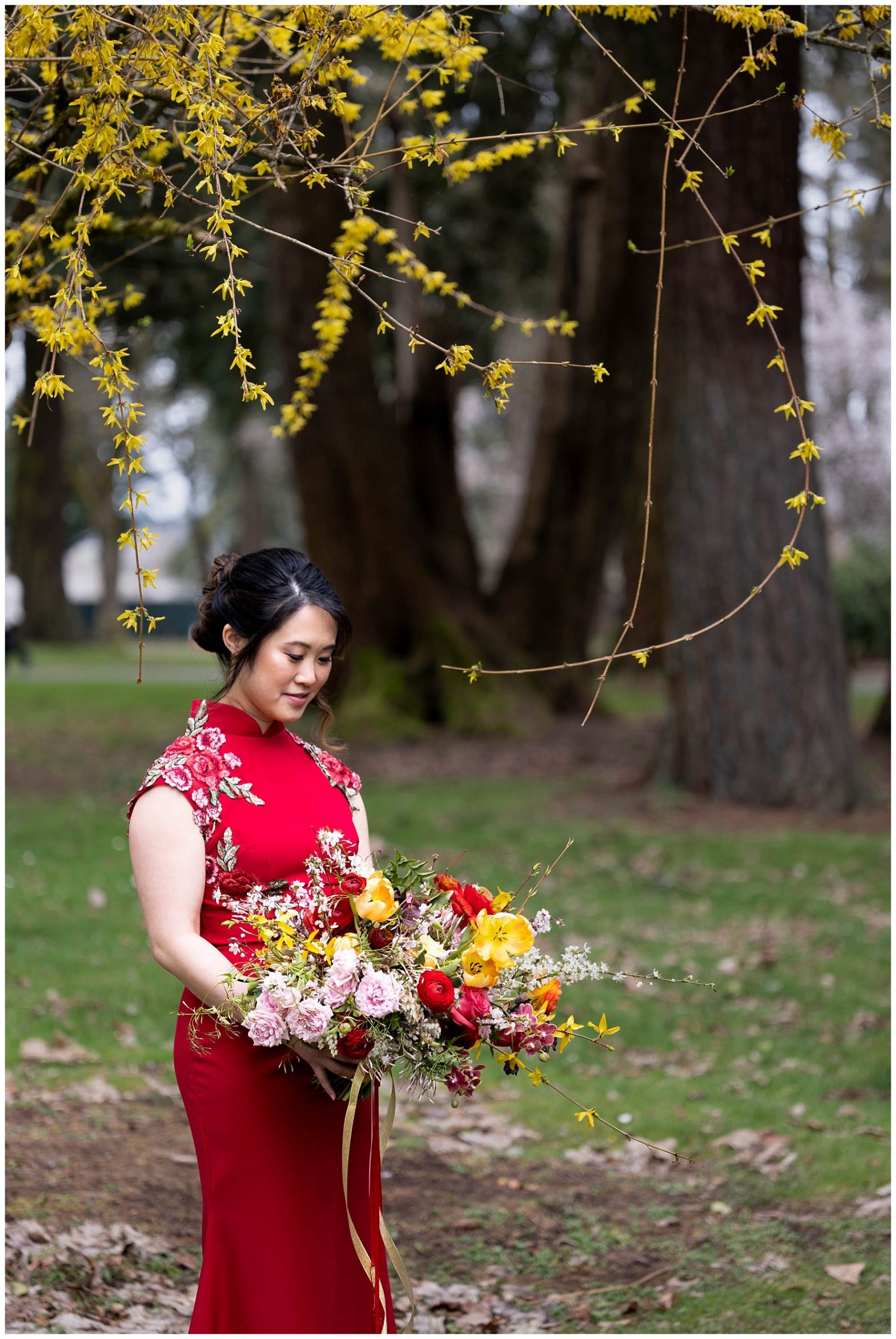

“It’s always an honor to be trusted to coordinate a wedding with cultural elements that are not from my own heritage, it means I get to expand my knowledge and build my experiences! I love working with couples who want to have a wedding, but in their own way. If that means incorporating traditions and rituals from their cultural background then I will do my best to help them do that.”

The most memorable wedding with cultural elements that Eva planned was at her favorite wedding venue, Almquist, with the sweetest couple who wanted to honor their Filipino heritage. They included a few aspects of Filipino-Catholic traditions before their vows: the veil and cord ritual. The mothers covered the bride and groom with a ceremonial veil symbolizing being clothed as one. Then the cord, or yugal, was wrapped around the couple like an infinity symbol, representing an eternal bond of fidelity. “It was a really touching moment to witness,” Eva remembers.
Eva says at some point in her career she would love to plan a Korean wedding. She’s seen a lot of photos of traditional Korean weddings, including those of her husband’s Korean-American friend that got married. The pictures showed an incredibly fun wedding. “As far as I understand there are games involved. There is some part where the bride jumps on the grooms back and he gives her a ride around,” Eva describes. “I don’t know why. It’s probably really entertaining for the guests and really fun for the couple themselves.”
CHINESE WEDDING TRADITIONS
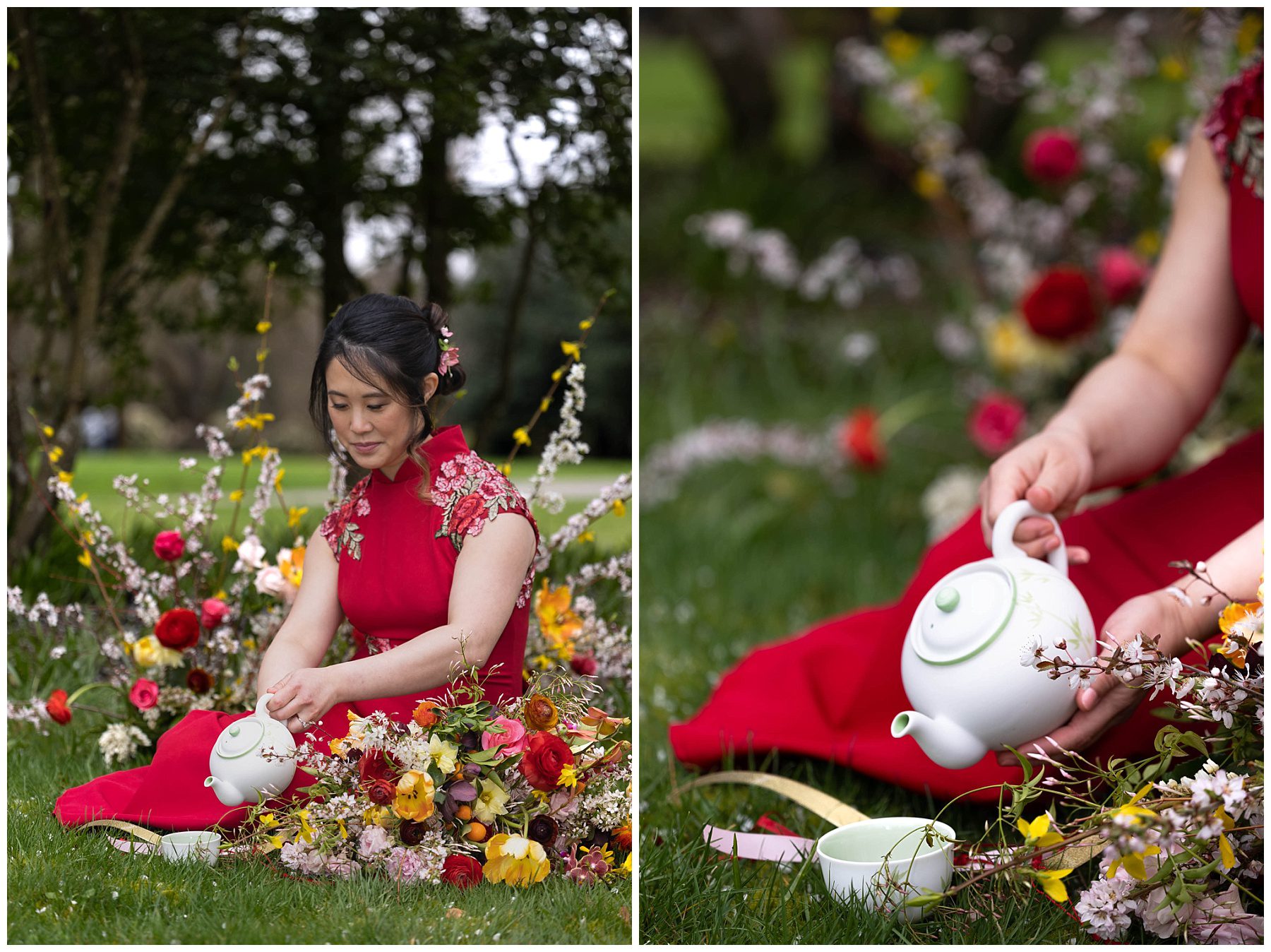
Eva’s favorite Chinese wedding tradition is the tea ceremony. “It’s a very simple ceremony,” Eva explains. “On paper it’s very simple – you’re literally just serving tea to your family and elders. But at the same time I feel like the meaning behind it, the symbolism, and how long that tradition has been around is pretty cool.” The Chinese tea ceremony is an event where the couple serves tea to their elders, usually their parents, which is symbolic of introducing the two families to one another. The act of drinking tea together demonstrates the parents welcoming and accepting a new person into their family. The tea ceremony is also indicative of respect and honor. “Thanking them for getting us to that point. Raising us and getting us to that point of being married,” Eva says.
“Without a doubt, my favorite tradition is the Tea Ceremony. It really seems like quite a simple gesture, the couple serves tea to their elders and the elders take a sip of tea. It’s a deeply symbolic, and joyful ritual of two families joining together and an opportunity for the marrying couple to pay respect and appreciation for those who raised them.”

In China you can hire professionals to perform the tea ceremony, but here in the United States, generally you have an older married female relative do the honors. I ask Eva if she and her husband had a relative perform their tea ceremony. “Yes, we had my dad’s cousin do it,” Eva explains. “She was invited as a guest. My mom was looking for someone who wouldn’t actually be receiving the tea, but knew enough about the ceremony to conduct it.”
While Eva would not take on the role of facilitating the Chinese tea ceremony herself as the wedding planner, she will help her couples plan it out in their timeline, as well as help them understand how long everything will take and the prep that goes into it, such as boiling the water for the tea. “There’s little things that not a lot of people realize will take time. Somebody’s responsible for doing that,” Eva informs me. “And then even making the tea. Usually it’s special and has special ingredients.” Our conversation is interrupted with the choice of false eyelash length, but I learn later on that the special ingredients are often things like red dates, lotus seeds, and lilies. “I would include that in the packing list to help them make sure they have everything the day of,” Eva says.
Before Western influence, the tea ceremony was the entire wedding in Chinese culture. Chinese weddings were small and intimate affairs with just the two families present. There was no white wedding gown for the bride, instead both the bride and the groom would wear red. The “qipao” or “qun kwa”, a full-length red dress with a high collar and an asymmetrical slit on one side was traditionally worn by the bride. The groom would wear a matching red jacket and pants, both embroidered. Sometimes the pants could be a simple black. Colors like white or blue, both in attire and décor, were (and still are) traditionally avoided at Chinese weddings, as they symbolize mourning.
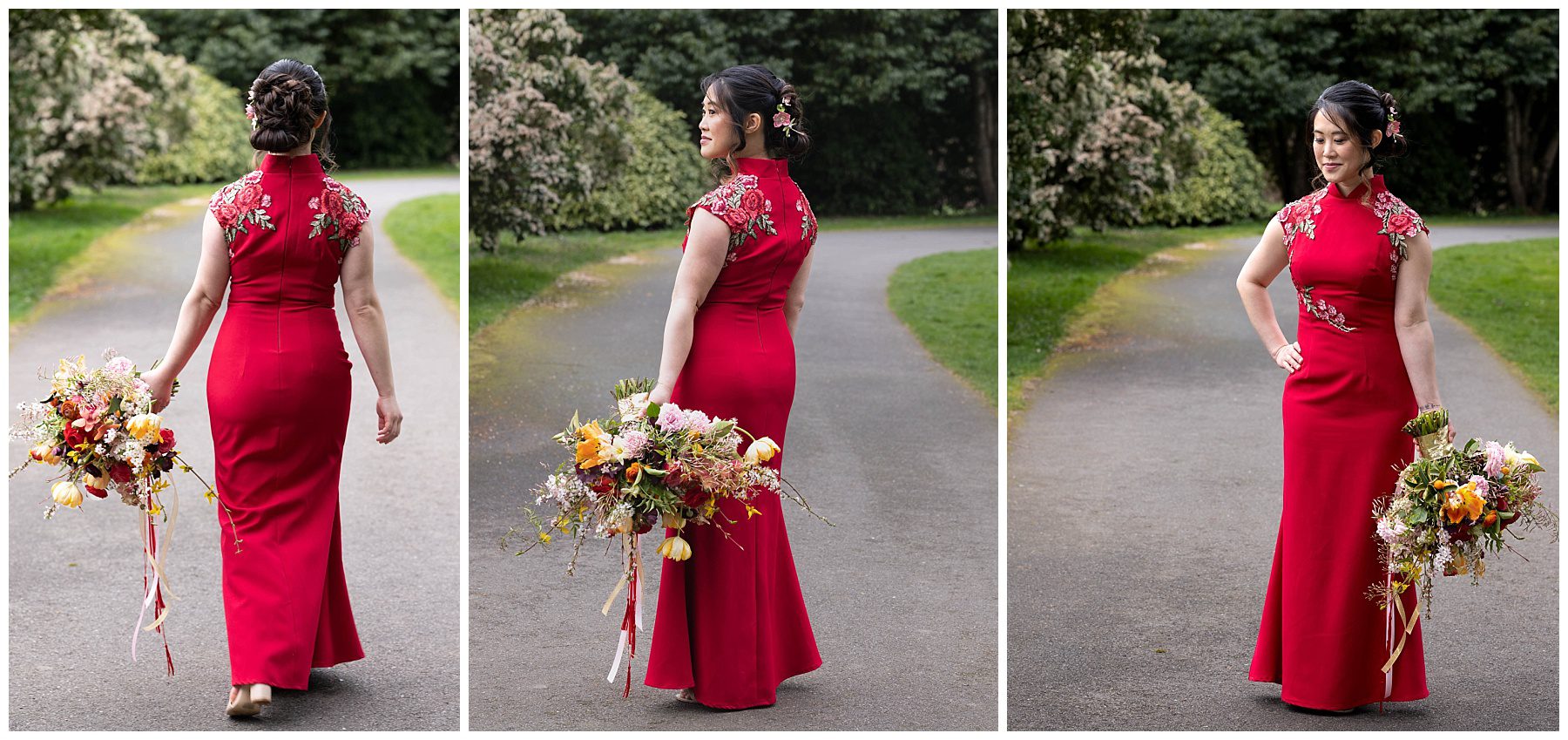
My husband, Mike, is third generation Chinese, but he and I had a very Western style wedding, with lots of friends and family in attendance. One of the things I wish we had done was make it a point to greet all of our guests. It was not something my husband and I discussed in our planning. As a result, there were some guests we didn’t get the opportunity to talk to at our wedding. In Chinese tradition, at the beginning of the reception the couple will stand by the doorway greeting everyone that comes in, while holding a gift box that guests can put greeting cards in or the traditional red envelope. I love the thought of this formal greeting line. If my husband and I have a vow renewal celebration in 20 years or whatever, this is what I will plan to do. Although I wouldn’t expect red envelopes. I am familiar with the red envelopes in Chinese culture, as my husband’s parents will usually give us each a red envelope with some money inside every Chinese New Year. “In Asian weddings there is no registry,” Eva explains. “You don’t bring a toaster or anything like that. You just bring cash.”
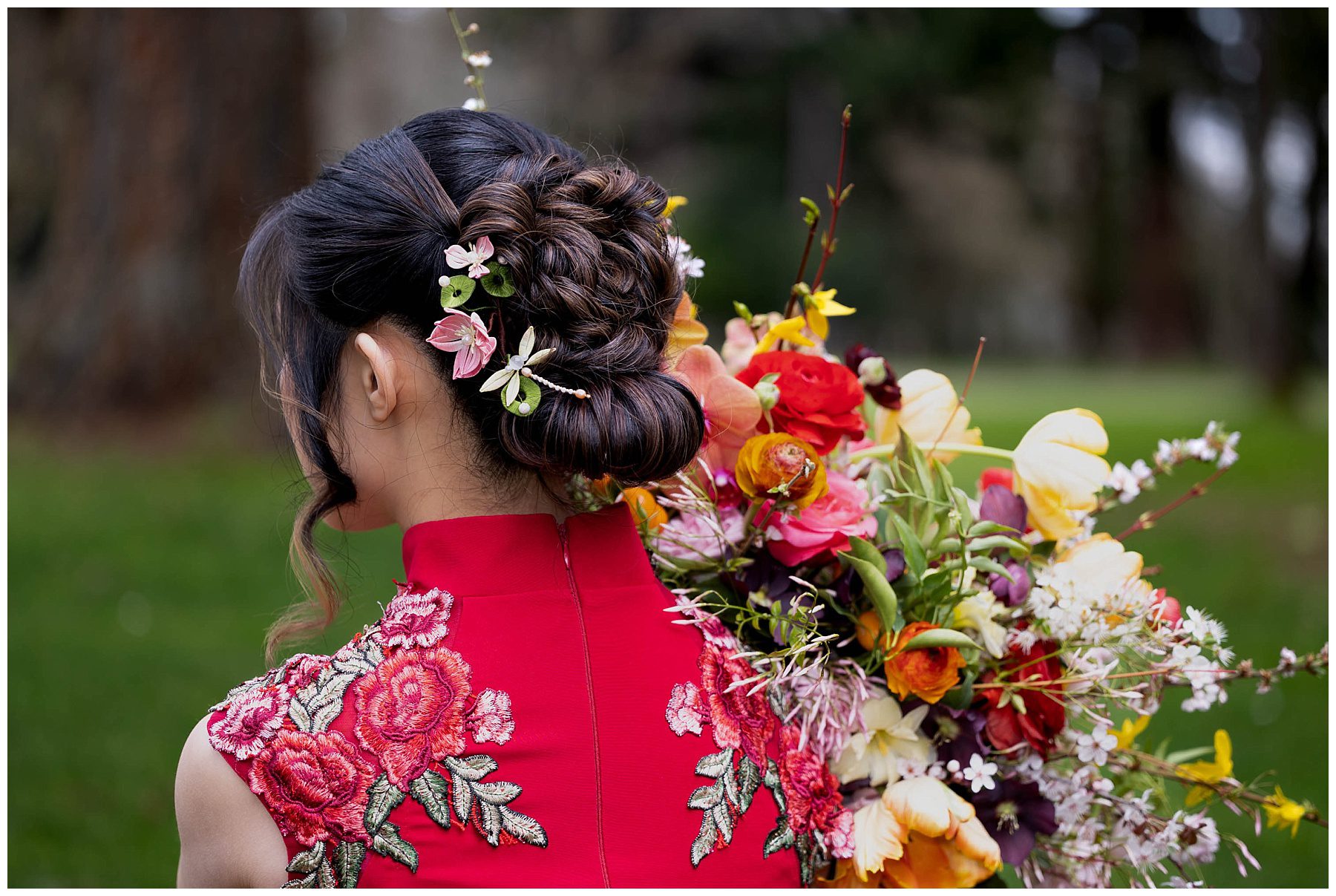
Another Chinese wedding tradition, one that Eva will help coordinate at a wedding this summer, is lion dancing. Lion dancers come to perform and bless your event, whether that’s a wedding, holiday, or other special event. “It’s crazy, you have to be super in shape and they train really, really hard for it,” Eva tells me. “There’s essentially two dancers under a lion costume, so they have the head and then the body of the lion. The heads weigh a good 20-30 pounds and they’re holding it for a good ten minute performance. And they’re not just holding it – they’re jumping around with it, doing a lot of tricks. The lion stands up, so the front person jumps on the person in the back. They jump on their thighs. The back person is kind of squatting. It’s incredible to watch.”
Earlier this year I was at a WIPA event that was lunar new year themed. Dancers, who were wearing dragon costumes, came and performed. I learn that usually if the dance troupe does lion dancing they will also do dragon dancing. At the WIPA event I remember seeing some of the attendees put money in the dragon’s mouth. “Feeding the dragon is good luck and in a way it’s tipping the performers,” Eva explains. The local dance troupe that Eva is most familiar with is Mak Fai.
THE FUTURE OF TRADITION – A PERSONAL, MODERN APPROACH
With Eva’s own wedding in 2018 at Woodinville at the Novelty-Hill Winery, she was very intentionally about subtly incorporating pieces of Chinese culture into the celebration. She didn’t want to have a traditional Chinese wedding, but rather, she wanted to add in little personal details that were important to her and her husband. “For us, it was adding the double happiness character symbol, the symbol for Chinese weddings,” she says. “Traditionally in Chinese weddings those [symbols] are hung up on walls and printed on signs. We just had the script design incorporated into our photo booth. I thought that was a fun way to incorporate that in.”
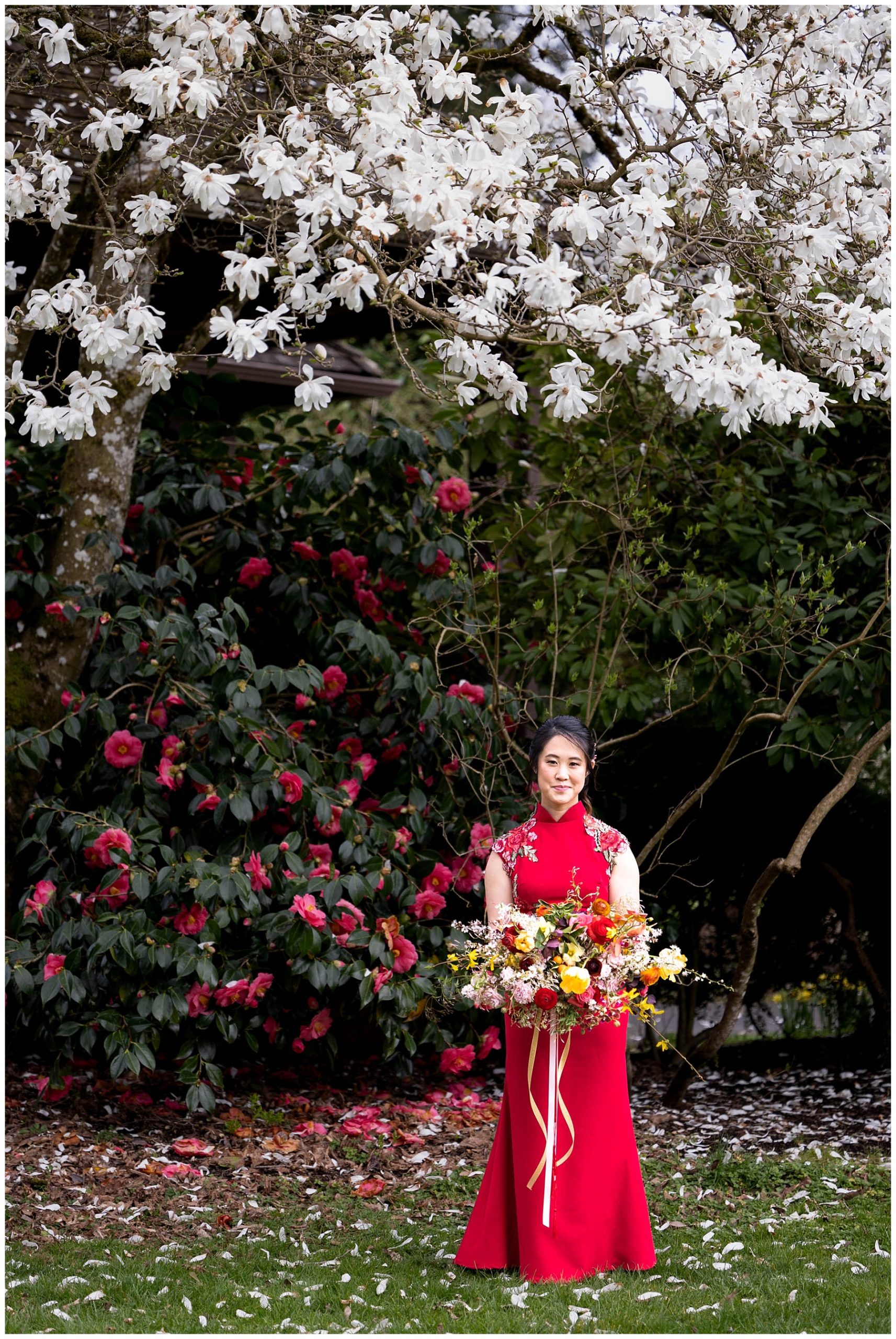

“Just like American weddings, I think aspects of Chinese weddings are constantly evolving and there are always new and creative trends. There’s no one way to have a Chinese wedding, even in Asia – couples of Chinese background celebrate very differently according to what country they are in and what’s important to them and their families.”

Incorporating traditions in a not so quite traditional method is a way to honor the past, but embody the modernity of the 21st century. In Chinese weddings this could be by using different colors, like shades red, instead of all bright red. Or even incorporating other colors like pink and gold.
The traditional qipao that Eva brought with her to our shoot was not the dress she wore to her tea ceremony. Eva’s mom had ordered it from China, but it wasn’t ready on time for Eva’s actual wedding. “It kind of worked out,” Eva recalls. “I couldn’t find a traditional dress that I really liked. They looked too traditional and I wanted a modern twist on it. So I found a burgundy dress that I really liked. And it had a high collar similar to traditional dresses, but it had a lace back. So I wore that one to the tea ceremony.”
On a side note, Eva mentions she ordered her burgundy dress from Lulu’s. In unison, Katie and I both exclaim that we love Lulu’s!
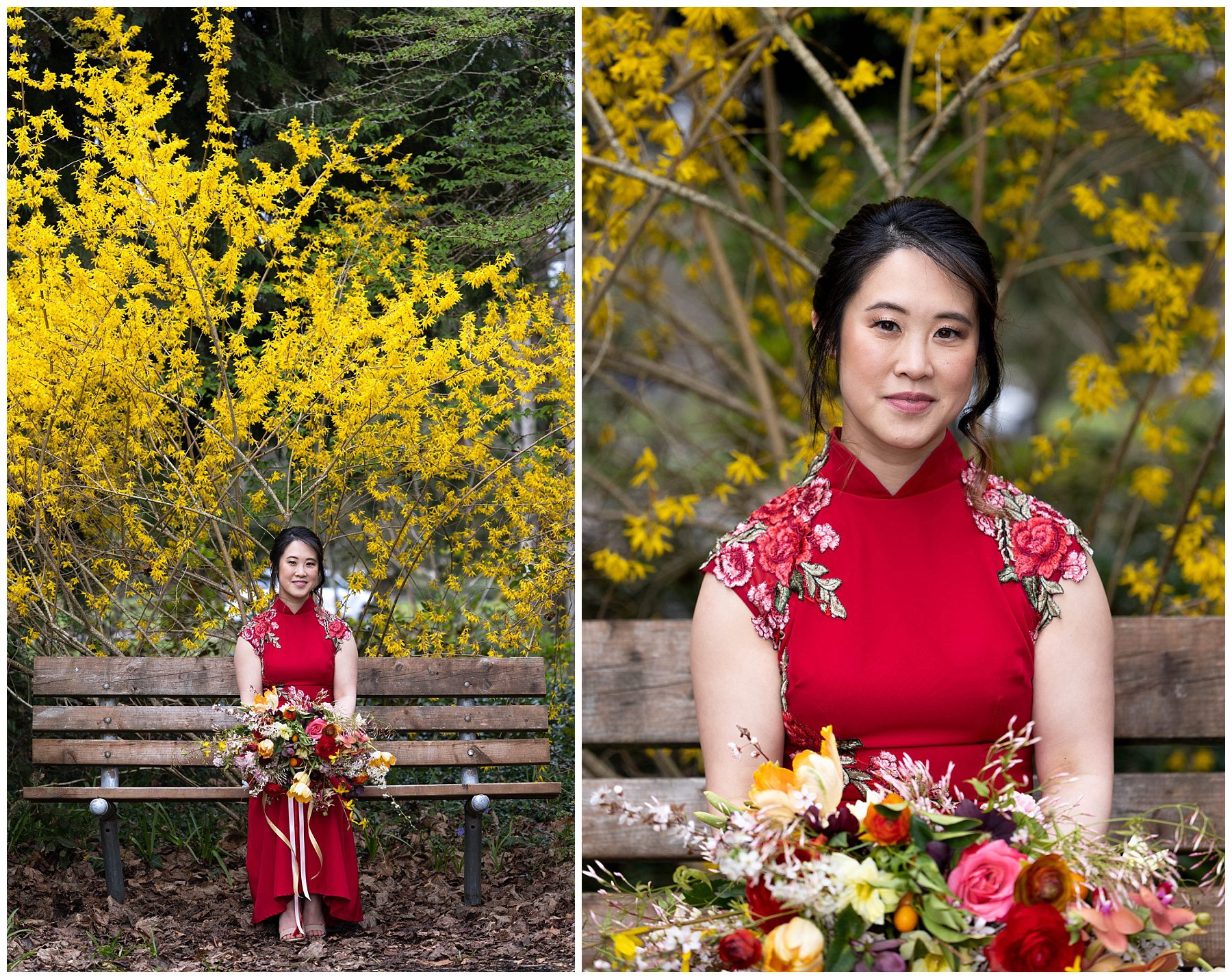
Beyond the realm of tradition, Eva values design elements that mean something. “I think there’s a lot of details in a wedding that could turn into something more personal. For example, like table numbers. You could just go ahead and purchase some table number. But if the groom is a professional poker player you could use cards as the table numbers. And it’s fun for guests, because people who only really know who him would make that connection,” she explains.
I, as a wedding florist, absolutely love when I am able to help couples incorporate little personal elements into their floral designs. I once worked with a couple who wanted to incorporate their Irish heritage into their wedding, so we focused on using woodsy botanic elements, like ferns, berries, and moss. The groom was an avid fly fisherman, so we also included fly fishing feathers into his boutonniere. Another time I worked with a couple where the bride was in grad school for mycology, the study of fungi, so we included ceramic mushrooms into her bridal bouquet.
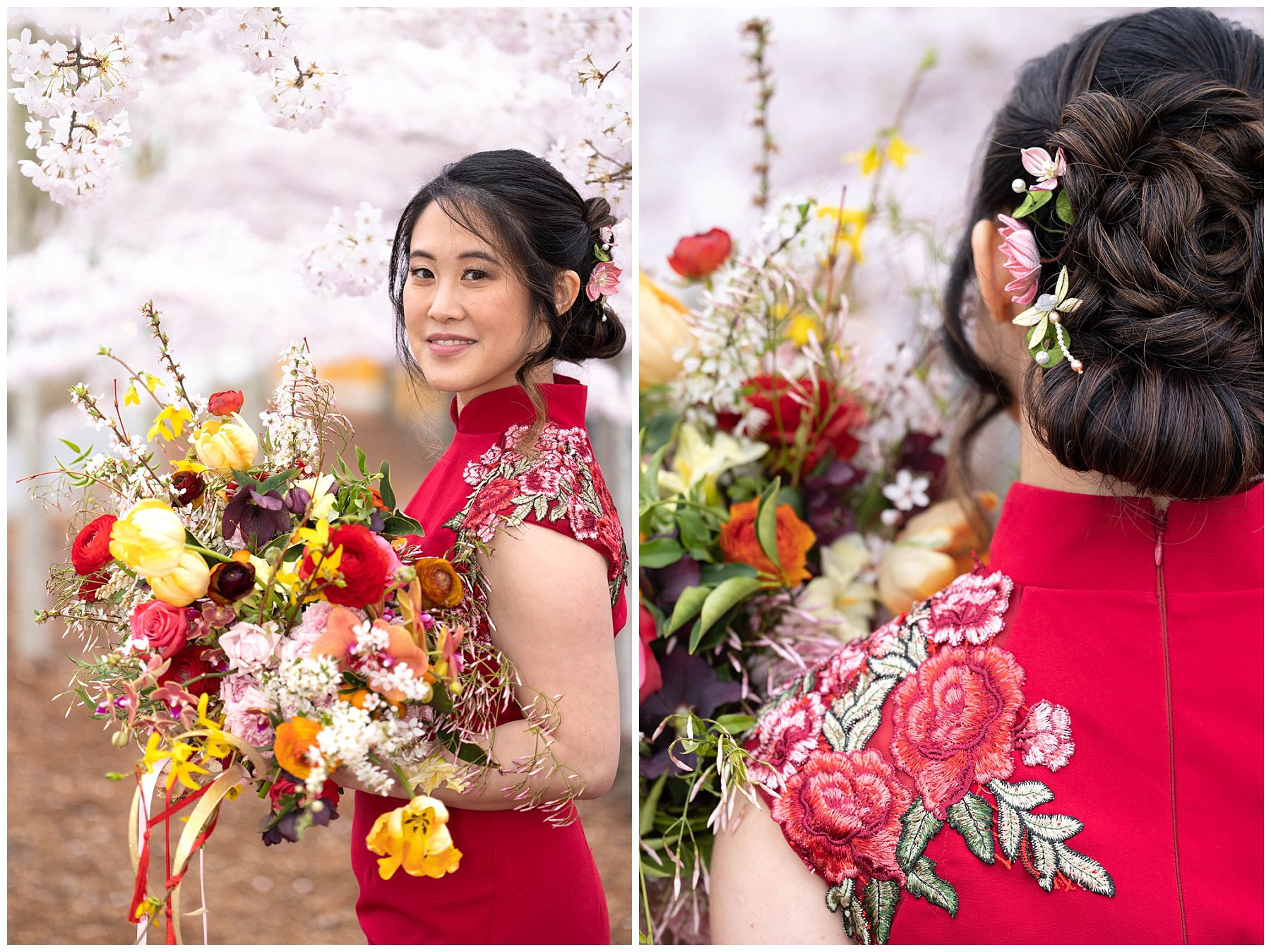
Incorporating elements into weddings that are meaningful to the couple, whether they stem from tradition or not, really does take those events to another level. Thoughtful, intentional design with meaning behind will always shine brightly.
Eva, we look forward to seeing all those personal touches in your weddings this season and beyond. What lucky couples you have!
